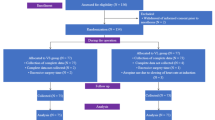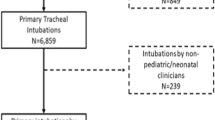Abstract
Objective
We hypothesized that videolaryngoscope use for tracheal intubations would differ across NICUs, be associated with higher first attempt success and lower adverse events.
Study design
Data from the National Emergency Airway Registry for Neonates (01/2015 to 12/2017) included intubation with direct laryngoscope or videolaryngoscope. Primary outcome was first attempt success. Secondary outcomes were adverse tracheal intubation associated events and severe desaturation.
Results
Of 2730 encounters (13 NICUs), 626 (23%) utilized a videolaryngoscope (3% to 64% per site). Videolaryngoscope use was associated with higher first attempt success (p < 0.001), lower adverse tracheal intubation associated events (p < 0.001), but no difference in severe desaturation. After adjustment, videolaryngoscope use was not associated with higher first attempt success (OR:1.18, p = 0.136), but was associated with lower tracheal intubation associated events (OR:0.45, p < 0.001).
Conclusion
Videolaryngoscope use is variable, not independently associated with higher first attempt success but associated with fewer tracheal intubation associated events.
This is a preview of subscription content, access via your institution
Access options
Subscribe to this journal
Receive 12 print issues and online access
$259.00 per year
only $21.58 per issue
Buy this article
- Purchase on SpringerLink
- Instant access to full article PDF
Prices may be subject to local taxes which are calculated during checkout

Similar content being viewed by others
Data availability
The datasets analysed during the current study are available from the corresponding author on reasonable request.
References
Hatch LD, Grubb PH, Lea AS, Walsh WF, Markham MH, Whitney GM, et al. Endotracheal Intubation in Neonates: A Prospective Study of Adverse Safety Events in 162 Infants. J Pediatr. 2016;168:62–6.e66.
Foglia EE, Ades A, Sawyer T, Glass KM, Singh N, Jung P, et al. Neonatal Intubation Practice and Outcomes: An International Registry Study. Pediatrics 2019;143:e20180902.
Haubner LY, Barry JS, Johnston LC, Soghier L, Tatum PM, Kessler D, et al. Neonatal intubation performance: room for improvement in tertiary neonatal intensive care units. Resuscitation. 2013;84:1359–64.
Page NE, Giehl M, Luke S. Intubation complications in the critically ill child. AACN Clin Issues. 1998;9:25–35.
Kaplan MB, Ward DS, Berci G. A new video laryngoscope-an aid to intubation and teaching. J Clin Anesth. 2002;14:620–6.
Weiss M, Schwarz U, Dillier CM, Gerber AC. Teaching and supervising tracheal intubation in paediatric patients using videolaryngoscopy. Paediatr Anaesth. 2001;11:343–8.
Vlatten A, Aucoin S, Litz S, Macmanus B, Soder C. A comparison of the STORZ video laryngoscope and standard direct laryngoscopy for intubation in the Pediatric airway - a randomized clinical trial. Pediatr Anesthesia. 2009;19:1102–7.
Fiadjoe JE, Kovatsis P. Videolaryngoscopes in pediatric anesthesia: What’s new? Minerva anestesiologica. 2014;80:76–82.
Vanderhal AL, Berci G, Simmons CF, Hagiike M. A Videolaryngoscopy Technique for the Intubation of the Newborn: Preliminary Report. Pediatrics. 2009;124:e339–46.
Vanderhal AL, Berci G, Simmons CF. Video Assisted Endotracheal Intubation: Role in Teaching and Acquiring Skills in Era of Decreasing DR and NICU Time during Residency Training. E-PAS2007:617907.2; 2007.
Donoghue AJ, Ades AM, Nishisaki A, Deutsch ES. Videolaryngoscopy versus direct laryngoscopy in simulated pediatric intubation. Ann Emerg Med. 2013;61:271–7.
Assaad M-A, Lachance C, Moussa A. Learning neonatal intubation using the videolaryngoscope: A randomized trial on mannequins. Simul Healthc. 2016;11:190–3.
Vanderhal AL, Berci G, Simmons CF Jr, Hagiike M. A videolaryngoscopy technique for the intubation of the newborn: Preliminary report. Pediatrics 2009;124:e339–346.
O’Shea JE, Thio M, Kamlin CO, McGrory L, Wong C, John J, et al. Videolaryngoscopy to teach neonatal intubation: A randomized trial. Pediatrics 2015;136:912–9.
Moussa A, Luangxay Y, Tremblay S, Lavoie J, Aube G, Savoie E, et al. Videolaryngoscope for teaching neonatal endotracheal intubation: A randomized controlled trial. Pediatrics 2016;137:e20152156.
Volz S, Stevens TP, Dadiz R. A randomized controlled trial: does coaching using video during direct laryngoscopy improve residents’ success in neonatal intubations? J Perinatol. 2018;38:1074–80.
Patel J, Posencheg M, Ades A. Proficiency and retention of neonatal resuscitation skills by pediatric residents. Pediatrics 2012;130:515–21.
Lingappan K, Arnold JL, Fernandes CJ, Pammi M. Videolaryngoscopy versus direct laryngoscopy for tracheal intubation in neonates. Cochrane Database Syst Rev. 2018;6:CD009975.
O’Shea JE, Kirolos S, Thio M, Kamlin COF, Davis PG. Neonatal videolaryngoscopy as a teaching aid: the trainees’ perspective. Arch Dis Child Fetal Neonatal Ed. 2021;106:168–71.
Thomas H, Lugg R, James B, Geeroms C, Risbridger A, Bell R, et al. Survey of the use of videolaryngoscopy in neonatal units in the UK. Arch Dis Child Fetal Neonatal Ed. 2021:fetalneonatal-2021-322813. https://doi.org/10.1136/archdischild-2021-322813.
Abid ES, McNamara J, Hall P, Miller KA, Monuteaux M, Kleinman ME, et al. The Impact of Videolaryngoscopy on Endotracheal Intubation Success by a Pediatric/Neonatal Critical Care Transport Team. Prehosp Emerg Care. 2021;25:325–32.
Xue FS, Li HX, Liu YY, Yang GZ. Current evidence for the use of C-MAC videolaryngoscope in adult airway management: a review of the literature. Ther Clin Risk Manag. 2017;13:831–41.
Cook TM, El-Boghdadly K, McGuire B, McNarry AF, Patel A, Higgs A. Consensus guidelines for managing the airway in patients with COVID-19: Guidelines from the Difficult Airway Society, the Association of Anaesthetists the Intensive Care Society, the Faculty of Intensive Care Medicine and the Royal College of Anaesthetists. Anaesthesia 2020;75:785–99.
Fiadjoe J, Nishisaki A. Normal and difficult airways in children: “What’s New”-Current evidence. Paediatr Anaesth. 2020;30:257–63.
Garcia-Marcinkiewicz AG, Kovatsis PG, Hunyady AI, Olomu PN, Zhang B, Sathyamoorthy M, et al. First-attempt success rate of video laryngoscopy in small infants (VISI): a multicentre, randomised controlled trial. Lancet 2020;396:1905–13.
Hu X, Jin Y, Li J, Xin J, Yang Z. Efficacy and safety of videolaryngoscopy versus direct laryngoscopy in paediatric intubation: A meta-analysis of 27 randomized controlled trials. J Clin Anesth. 2020;66:109968.
Klabusayová E, Klučka J, Kosinová M, Ťoukálková M, Štoudek R, Kratochvíl M, et al. Videolaryngoscopy vs. Direct Laryngoscopy for Elective Airway Management in Paediatric Anaesthesia: A prospective randomised controlled trial. Eur J Anaesthesiol. 2021;38:1187–93.
Hoshijima H, Mihara T, Maruyama K, Denawa Y, Mizuta K, Shiga T, et al. C-MAC videolaryngoscope versus Macintosh laryngoscope for tracheal intubation: A systematic review and meta-analysis with trial sequential analysis. J Clin Anesth. 2018;49:53–62.
Tippmann S, Haan M, Winter J, Mühler AK, Schmitz K, Schönfeld M, et al. Adverse events and unsuccessful intubation attempts are frequent during neonatal nasotracheal intubations. Front Pediatr. 2021;9:675238.
Vlatten A, Aucoin S, Litz S, Macmanus B, Soder C. A comparison of the STORZ video laryngoscope and standard direct laryngoscopy for intubation in the Pediatric airway-a randomized clinical trial. Paediatr Anaesth. 2009;19:1102–7.
O’Shea JE, Loganathan P, Thio M, Kamlin COF, Davis PG. Analysis of unsuccessful intubations in neonates using videolaryngoscopy recordings. Arch Dis Child Fetal Neonatal Ed. 2018;103:F408–12.
Pouppirt NR, Nassar R, Napolitano N, Nawab U, Nishisaki A, Nadkarni V, et al. Association between video laryngoscopy and adverse tracheal intubation-associated events in the neonatal intensive care unit. J Pediatr. 2018;201:281–4 e281.
Acknowledgements
The authors would like to thank the healthcare teams at participating NEAR4NEOS sites for their diligent completion of NEAR4NEOS data collection forms. They also like to thank Hayley Buffman at Children’s Hospital of Philadelphia as a coordinator for the NEAR4NEOS collaborative.
Funding
This study was supported by Eunice Kennedy Shriver NICHD R21 HD089151.
Author information
Authors and Affiliations
Consortia
Contributions
AM has contributed to conception and design, acquisition of data, analysis and interpretation of data. He has written the first draft of this specific article and modified subsequent drafts until all authors approved the final version of the article. TJ, MPD, EEF, AA, NN, KMG, LJ, PJ, NS, BHQ, JB, JZ, SD, AAM and VN have contributed to acquisition of data and revised the article critically for important intellectual content. AN has contributed to conception and design, acquisition of data, analysis and interpretation of data; and revised the article critically for important intellectual content. All authors agree to be accountable for all aspects of the work. They ensure that questions relating to accuracy or integrity of any part of the work are appropriately investigated and resolved. All authors have approved the final version of the article as sent to Journal of Perinatology.
Corresponding author
Ethics declarations
Competing interests
The authors declare no competing interests.
Additional information
Publisher’s note Springer Nature remains neutral with regard to jurisdictional claims in published maps and institutional affiliations.
Supplementary information
Rights and permissions
Springer Nature or its licensor holds exclusive rights to this article under a publishing agreement with the author(s) or other rightsholder(s); author self-archiving of the accepted manuscript version of this article is solely governed by the terms of such publishing agreement and applicable law.
About this article
Cite this article
Moussa, A., Sawyer, T., Puia-Dumitrescu, M. et al. Does videolaryngoscopy improve tracheal intubation first attempt success in the NICUs? A report from the NEAR4NEOS. J Perinatol 42, 1210–1215 (2022). https://doi.org/10.1038/s41372-022-01472-9
Received:
Revised:
Accepted:
Published:
Issue date:
DOI: https://doi.org/10.1038/s41372-022-01472-9
This article is cited by
-
Outcomes, safety and health economics of introduction of video laryngoscopy-assisted less invasive surfactant administration
Journal of Perinatology (2025)
-
Video versus direct laryngoscopy for urgent intubation of newborn infants
Canadian Journal of Emergency Medicine (2025)
-
Factors that determine first intubation attempt success in high-risk neonates
Pediatric Research (2024)
-
Manikin to patient intubation: does it translate?
Journal of Perinatology (2023)



